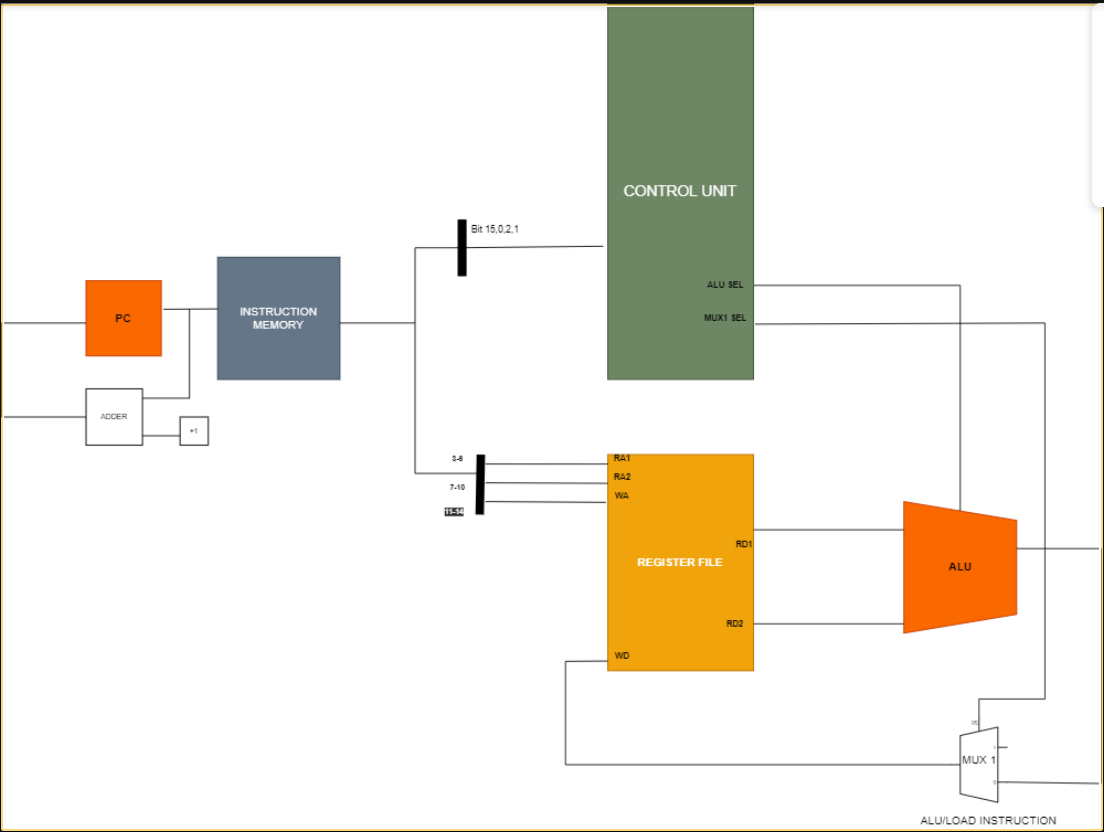Designing a 16-bit functional microprocessor with basic operations from scratch with Logisim. This is solely for academic purposes.
This is an educational project, with the goal of learning and building how microprocessors work at a low level by implementing a complete, functional 16 bit computer in Logisim.
-
How many instructions? - 16 instructions
-
How many registers? - 16 16-bit registers
-
What size of processor? - 16-bit microprocessor
-
What size of instructions? - 16-bit size instructions
-
What architecture? - Harvard Architecture.
| ALU | Branch | Memory |
|---|---|---|
| Add | Beq | Load |
| Sub | Bne | Store |
| Mul | Jump | |
| Div | ||
| Two's Complement | ||
| XOR | ||
| AND | ||
| OR | ||
| ORi | ||
| ANDi | ||
| ADDi |
- Format of instructions -
Sample DataPath Image
Install Logisim, following instructions at http://www.cburch.com/logisim/.
The entire computer is contained in main.circ.
- Arithmetic Logic Unit
- Control Unit
- Register file
- Data Path
- Addition : 0000
- Subtraction : 0001
- Multiplication : 0000
- Divider : 0011
- AND : 0100
- OR : 0101
- XOR : 0110
- Negation : 0111
- ADDi : 1011
- ORi : 1110
- ANDi : 1111
The ALU generates three outputs; the output of an ALU operation, a branch equal signal and a branch not equal signal
The register file contains registers that are 16-bit and capable of keeping data for operations in the processor
- Branch Equal(BEQ) : 1000
- Branch Not Equal (BNE) : 1001
- Jump : 1010
- Load : 1100
- Store : 1101
The control unit accepts four inputs and outputs 11 control signals to be used by the rest of the processor. The four inputs are Bits 15, 2,1,0.
There are 4 main multiplexers:
Labeled MUX1: This multiplexer is for selecting whether the data needed to write to the register file is from an ALU output or a load operation from memory into register file
Labeled MUX2: This multiplexer is for selecting between a load or a store operation. It is used to determine what operands to use as the instruction formats for load and store differ between where memory and register are located.
Labeled MUX3: This multiplexer is used when we are performing either an immediate or a basic ALU operation. Basic ALU operations use data from the register and immediate operations use constant values specified in the instruction.
Labeled MUX4: This multiplexer selects whether an operation is a JUMP, BRANCH EQUAL, BRANCH NOT EQUAL.
This describes how programs react when they meet a condition.
-
The initial designs are organized into one folder.
-
New designs should be added to the main.circ in the main_designs directory.
-
The main.circ Logisim file has sub-circuits for ALU, register_file, CU.
-
We'll do all our circuit designs in there.
-
Let's get some work done
-
Format of instructions :
ALU
| 15 | 14 -11 | 10 - 7 | 6-3 | 2 | 1-0 |
|---|---|---|---|---|---|
| Selecting between ALU and the other operations | Destination Register Address | Source Register 2 Address | Source Register 1 Address | Bit to detemine between Logic or Arithmetic Operations | Particular Operation |
Sample ALU Instruction: 0090h - Add reg0, reg 1, reg 2(Add value in register 1 to register 2 and store it in register 0).
Store
| 15 | 14 - 7 | 6 - 3 | 2 - 0 |
|---|---|---|---|
| Selecting between ALU and the other operations | Selecting RAM Address | Register Address from which data is sourced | Selecting whether it is a Load/Store Operation |
Sample Store Operation: 8005h - STR r0, [r0] (Store value in register 0 (0000) in 8-bit RAM Address stored in r0 )
Load
| 15 | 14 - 11 | 10 - 3 | 2 - 0 |
|---|---|---|---|
| Selecting between ALU and the other operations | Register Address | Address for data in RAM | Selecting whether it is a Load/Store Operation |
Sample Load Operation: c004h - LDR r4, [r0] (Load from 8 bit RAM Address in register 0 (0000) into register 4(0100) )
Instruction Formats:
Branch Equal
| 15 | 14-11 | 10 - 7 | 6 - 3 | 2 - 0 |
|---|---|---|---|---|
| Selecting between ALU and the other operations | Offset | Register address with second operand to compare | Register address with first operand to compare | Opcode for Beq operation |
Sample Branch-equal instruction: E9A0 - Beq reg3,reg4, -3 (check the contents of register 3 and 4, if equal move two step back from the current instruction)
Branch Not Equal
| 15 | 14 - 11 | 10 - 7 | 6 - 3 | 2 - 0 |
|---|---|---|---|---|
| Selecting between ALU and the other operations | Offset | Register address with second operand to compare | Register address with first operand to compare | Opcode for Bne operation |
Jump
| 15 | 14 - 12 | 10 - 3 | 2 - 0 |
|---|---|---|---|
| Selecting between ALU and the other operations | Unused | New address in instruction memory to jump to | Opcode for Jump operation |
Find the DataPaths for the various units in the presentation document.
You might want to read the post Machu wrote on building MicroL'afentika


